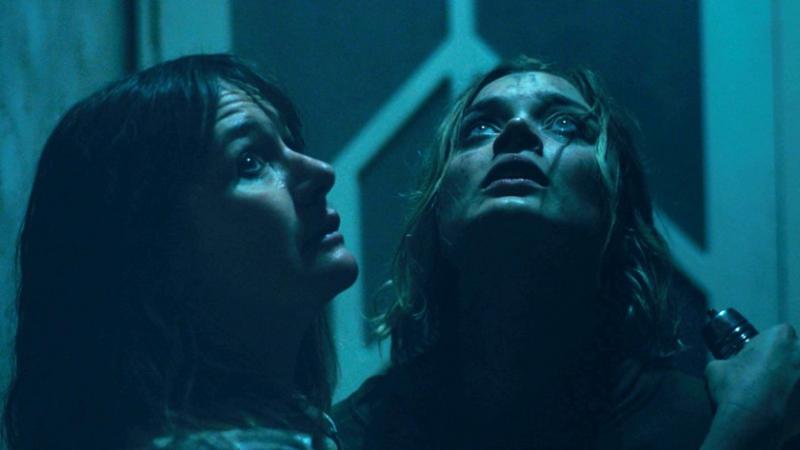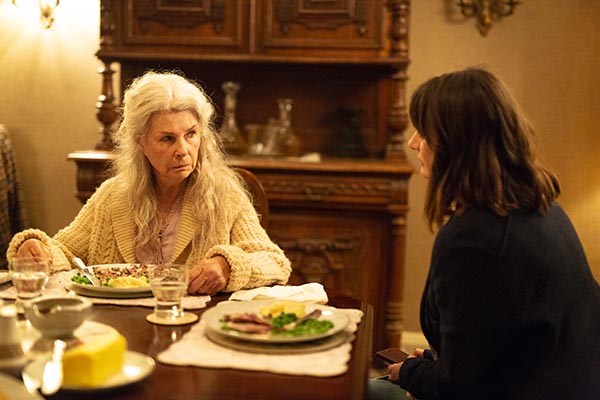Relic review – a deadly disappearing act | reviews, news & interviews
Relic review – a deadly disappearing act
Relic review – a deadly disappearing act
A family of women reaps the wrath of dementia

The bleak power of the Australian horror movie Relic, Natalie Erika James’s feature debut, derives from its masterful use of a simple metaphor.
Having learned that Edna is absent from the big, gabled wood-frame house in Creswick, Victoria, where she lives alone, Kay, apparently a business proprietor in her mid-to-late forties, and Sam, a disenchanted student of about 26, drive there from Melbourne, 75 miles to the south-east, around Christmastime. They find the house is locked and – after Sam climbs through a cat flap – that it’s dirty and untidy, if scarcely dilapidated. (Below: Robyn Nevin and Emily Mortimer)
 Expressing guilt for not having visited Edna a few weeks previously after she’d indicated she was scared of someone or something getting into the house, Kay starts to clean up. When she tells Sam she doesn’t know what she's doing, Sam helpfully rejoins that she’s already doing it – without straining herself to help. There’s a faint but perceptible generational disconnect between them, as possibly there was between Kay and Edna. Since James doesn’t muddy the waters by introducing male relatives, however, it’s implied that whatever they feel about their nearest and dearest, it is women who take responsibility for the caregiving in this family, as they do in many others.
Expressing guilt for not having visited Edna a few weeks previously after she’d indicated she was scared of someone or something getting into the house, Kay starts to clean up. When she tells Sam she doesn’t know what she's doing, Sam helpfully rejoins that she’s already doing it – without straining herself to help. There’s a faint but perceptible generational disconnect between them, as possibly there was between Kay and Edna. Since James doesn’t muddy the waters by introducing male relatives, however, it’s implied that whatever they feel about their nearest and dearest, it is women who take responsibility for the caregiving in this family, as they do in many others.
An organized search in the nearby woods only ratchets up Kay’s anxiety. Smoking on a side porch at night, Sam chats with the friendly young neighbour Jamie (Chris Bunton, an actor, writer, and gymnast with Down Syndrome), who admits he hasn’t visited Edna lately; it transpires that when he last called on her she locked him in a closet during a game of hide and seek. In a chilling sequence redolent of the Japanese and American Ring movies, and Mulholland Dr., too, a dream of Kay's that she relays to Sam shows her point-of-view discovery of a decaying person in the mould-ridden cabin, long-since demolished, where her mentally infirm grandfather once lived. One of the cabin's Tiffany-ish windows has been incorporated in Edna’s house. Like an heirloom Sam receives from Edna after she turns up, the window is a talisman symbolizing hereditary rot. Edna's Post-it notes, bearing her scribbled practical reminders and emotional fillips, more bluntly reveal how lonely and desperate she had become.
Edna is perfectly lucid when Kay finds her in the kitchen the following morning, but unable or unwilling to tell her where she’d been. The doctor summoned to examine her says she’s unharmed, apart from a huge bruise on her chest that’s mirrored in the black mould Kay and Sam find ascending one of the walls. While Kay is visiting Melbourne to find a care home for Edna, the theoretically more empathetic Sam suggests she could move in with Edna to help her. The ensuing conflict between Kay and Sam barely registers before the rapidly ailing Edna – now recognizing neither of them – goes on the rampage.
A Melbourne-based Japanese-Australian born in the US, James was inspired to write Relic and the 2017 short Creswick, a conceptual dry run for the feature, after travelling to rural Japan to visit her grandmother, who had Alzheimer’s disease and no longer recognized her; as a child, James had spent many summers in the grandmother’s “really creepy traditional Japanese house”. Unlike the expressionistically lit and embellished haunted Adelaide house of Jennifer Kent’s The Babadook (2014), which influenced James, Edna’s house was naturalistically photographed with minimal lighting – sometimes just candles or iPhone flashlights – by Charlie Sarroff, who had shot Creswick. Initially, it’s less frightening, despite the muffled creaks it issues, than dank and depressing.
 James’s masterstroke was having Sam explore the closet where Edna had imprisoned Jamie. It’s not a built-in wardrobe but the entrance to the cluttered, claustrophobic labyrinth that inexplicably runs for hundreds of yards behind the walls. This warren, in which Sam and Kay eventually become the deranged Edna’s quarry, is akin to Edna’s state of consciousness as it approaches its final eclipse. It’s where she sees Kay and Sam not as loving relatives but as hostile strangers who must be eliminated.
James’s masterstroke was having Sam explore the closet where Edna had imprisoned Jamie. It’s not a built-in wardrobe but the entrance to the cluttered, claustrophobic labyrinth that inexplicably runs for hundreds of yards behind the walls. This warren, in which Sam and Kay eventually become the deranged Edna’s quarry, is akin to Edna’s state of consciousness as it approaches its final eclipse. It’s where she sees Kay and Sam not as loving relatives but as hostile strangers who must be eliminated.
Outside it, in the living space, the peeling away of Edna’s identity continues as the film draws to its close. A comforting communal action allows for fleeting relief, but the final thing Sam sees indicates this won’t be her last experience of a neuro-degenerative disorder.
David Cronenberg’s Shivers (1975) and Rabid (1977) are often cited as films that prophesied AIDS, while his 1986 The Fly has been described as an AIDS parable, but few horror films have so effectively harnessed genre tropes to address a clinical illness directly as Relic. Thanks to the stringent performances of Nevin, Mortimer, and Heathcote, and to James’s deft balancing of dread and compassion, as well as her equal concern for the sick woman and her traumatised daughter and granddaughter, Relic’s metaphorical take on dementia is no less serious than the conventional depictions of it in Iris (2001), Away From Her (2006), and Amour (2012). It’s a salutary reminder, too, that at some point most of us will encounter it one way or another.
rating
Share this article
The future of Arts Journalism
You can stop theartsdesk.com closing!
We urgently need financing to survive. Our fundraising drive has thus far raised £49,000 but we need to reach £100,000 or we will be forced to close. Please contribute here: https://gofund.me/c3f6033d
And if you can forward this information to anyone who might assist, we’d be grateful.

Subscribe to theartsdesk.com
Thank you for continuing to read our work on theartsdesk.com. For unlimited access to every article in its entirety, including our archive of more than 15,000 pieces, we're asking for £5 per month or £40 per year. We feel it's a very good deal, and hope you do too.
To take a subscription now simply click here.
And if you're looking for that extra gift for a friend or family member, why not treat them to a theartsdesk.com gift subscription?
more Film
 Train Dreams review - one man's odyssey into the American Century
Clint Bentley creates a mini history of cultural change through the life of a logger in Idaho
Train Dreams review - one man's odyssey into the American Century
Clint Bentley creates a mini history of cultural change through the life of a logger in Idaho
 Palestine 36 review - memories of a nation
Director Annemarie Jacir draws timely lessons from a forgotten Arab revolt
Palestine 36 review - memories of a nation
Director Annemarie Jacir draws timely lessons from a forgotten Arab revolt
 Relay review - the method man
Riz Ahmed and Lily James soulfully connect in a sly, lean corporate whistleblowing thriller
Relay review - the method man
Riz Ahmed and Lily James soulfully connect in a sly, lean corporate whistleblowing thriller
 Die My Love review - good lovin' gone bad
A magnetic Jennifer Lawrence dominates Lynne Ramsay's dark psychological drama
Die My Love review - good lovin' gone bad
A magnetic Jennifer Lawrence dominates Lynne Ramsay's dark psychological drama
 Bugonia review - Yorgos Lanthimos on aliens, bees and conspiracy theories
Emma Stone and Jesse Plemons excel in a marvellously deranged black comedy
Bugonia review - Yorgos Lanthimos on aliens, bees and conspiracy theories
Emma Stone and Jesse Plemons excel in a marvellously deranged black comedy
 theartsdesk Q&A: director Kelly Reichardt on 'The Mastermind' and reliving the 1970s
The independent filmmaker discusses her intimate heist movie
theartsdesk Q&A: director Kelly Reichardt on 'The Mastermind' and reliving the 1970s
The independent filmmaker discusses her intimate heist movie
 Blu-ray: Wendy and Lucy
Down-and-out in rural Oregon: Kelly Reichardt's third feature packs a huge punch
Blu-ray: Wendy and Lucy
Down-and-out in rural Oregon: Kelly Reichardt's third feature packs a huge punch
 The Mastermind review - another slim but nourishing slice of Americana from Kelly Reichardt
Josh O'Connor is perfect casting as a cocky middle-class American adrift in the 1970s
The Mastermind review - another slim but nourishing slice of Americana from Kelly Reichardt
Josh O'Connor is perfect casting as a cocky middle-class American adrift in the 1970s
 Springsteen: Deliver Me From Nowhere review - the story of the Boss who isn't boss of his own head
A brooding trip on the Bruce Springsteen highway of hard knocks
Springsteen: Deliver Me From Nowhere review - the story of the Boss who isn't boss of his own head
A brooding trip on the Bruce Springsteen highway of hard knocks
 The Perfect Neighbor, Netflix review - Florida found-footage documentary is a harrowing watch
Sundance winner chronicles a death that should have been prevented
The Perfect Neighbor, Netflix review - Florida found-footage documentary is a harrowing watch
Sundance winner chronicles a death that should have been prevented
 Blu-ray: Le Quai des Brumes
Love twinkles in the gloom of Marcel Carné’s fogbound French poetic realist classic
Blu-ray: Le Quai des Brumes
Love twinkles in the gloom of Marcel Carné’s fogbound French poetic realist classic
 Frankenstein review - the Prometheus of the charnel house
Guillermo del Toro is fitfully inspired, but often lost in long-held ambitions
Frankenstein review - the Prometheus of the charnel house
Guillermo del Toro is fitfully inspired, but often lost in long-held ambitions

Add comment